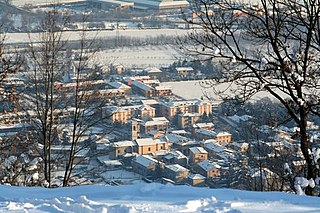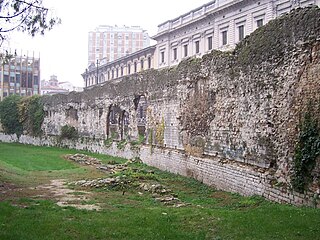Siege of Brescia can refer to:
Siege of Brescia can refer to:

Year 1238 (MCCXXXVIII) was a common year starting on Friday of the Julian calendar.

Year 1155 (MCLV) was a common year starting on Saturday of the Julian calendar.

Year 250 (CCL) was a common year starting on Tuesday of the Julian calendar. At the time, it was known as the Year of the Consulship of Traianus and Gratus. The denomination 250 for this year has been used since the early medieval period, when the Anno Domini calendar era became the prevalent method in Europe for naming years.

The Aryan Republican Army (ARA), also dubbed "The Midwest Bank bandits" by the FBI and law-enforcement, was a white nationalist terrorist gang which robbed 22 banks in the Midwest from 1994 to 1996. The bank robberies were spearheaded by Donna Langan. The gang, who had links to Neo-Nazism and white supremacism, were alleged to have conspired with convicted terrorist Timothy McVeigh in the months before the Oklahoma City bombing terrorist attack. Although it has never been proven, many theorists believe the ARA funneled robbery money to help fund the bombing as a direct response to the Waco and Ruby Ridge sieges.

Collebeato is a town and comune in the province of Brescia, in Lombardy, Italy. It is located on the right bank of the river Mella, 5 kilometres (3.1 mi) north of Brescia.
Corte de' Frati is a municipality (comune) in the province of Cremona, in the Lombardy Italian region.
Manerbio is a town and comune in the province of Brescia, in Lombardy, northern Italy. It received the honorary title of city with a presidential decree on May 14, 1997.

Pontevico is a comune in the province of Brescia in Lombardy. It is on the left bank of the river Oglio. As of 2021 Pontevico had a population of 7,038.

Peschiera del Garda is a town and comune in the province of Verona, in Veneto, Italy. When Lombardy-Venetia was under Austrian rule, Peschiera was the northwest anchor of the four fortified towns constituting the Quadrilatero. The fortress is on an island in the river Mincio at its outlet from Lake Garda.
The siege of Brescia occurred in 1238. After his victory the previous year at the battle of Cortenuova, Emperor Frederick sought to bring about the unconditional surrender of the city of Milan and its allies. Assembling his army in Verona in April 1238, which included a contingent of Nicene troops dispatched by Emperor John III, he decided to besiege the Guelf town of Brescia. Emperor Frederick began the siege on 11 July 1238 and it lasted until a successful sortie by the city's defenders in early October forced him to lift the siege.

The Battle of Castiglione saw the French Army of Italy under General Napoleon Bonaparte attack an army of the Habsburg monarchy led by Feldmarschall Dagobert Sigmund von Wurmser on 5 August 1796. The outnumbered Austrians were defeated and driven back along a line of hills to the river crossing at Borghetto, where they retired beyond the Mincio River. The town of Castiglione delle Stiviere is located 10 kilometres (6 mi) south of Lake Garda in northern Italy. This battle was one of four famous victories won by Bonaparte during the War of the First Coalition, part of the French Revolutionary Wars. The others were Bassano, Arcole, and Rivoli.

Asola is a comune in the province of Mantua, Lombardy. It received the honorary title of city with a presidential decree of October 23, 1951.
Castelnuovo or Castel Nuovo may refer to :

The Ten Days of Brescia was a revolt which broke out in the northern Italian city of that name, which lasted from 23 March to 1 April 1849.

The 27th Infantry Division "Brescia" was an infantry division of the Royal Italian Army during World War II. The Brescia was named after the city of Brescia in Lombardy. The Brescia was classified as an auto-transportable division, meaning it had some motorized transport, but not enough to move the entire division at once.

The Battle of Lonato was fought on 3 and 4 August 1796 between the French Army of Italy under General Napoleon Bonaparte and a corps-sized Austrian column led by Lieutenant General Peter Quasdanovich. A week of hard-fought actions that began on 29 July and ended on 4 August resulted in the retreat of Quasdanovich's badly mauled force. The elimination of Quasdanovich's threat allowed Bonaparte to concentrate against and defeat the main Austrian army at the Battle of Castiglione on 5 August. Lonato del Garda is located near the SP 668 highway and the Brescia-Padua section of Autostrada A4 to the southwest of Lake Garda.
Marino Becichemo or Marin Beçikemi was an Albanian scholar and orator who was a prominent humanist in the cities of Brescia and later Padua in the Republic of Venice in the early 16th century. He maintained a humanist school and was a professor in the University of Padua. He wrote commentaries about classical Latin literature and was well known for his orations in the region of Venice.

Brescia is a city and comune (municipality) in the region of Lombardy, in northern Italy. It is situated at the foot of the Alps, a few kilometers from the lakes Garda and Iseo. With a population of more than 200,000, it is the second largest city in Lombardy and the fourth largest in northwest Italy. The urban area of Brescia extends beyond the administrative city limits and has a population of 672,822, while over 1.5 million people live in its metropolitan area. The city is the administrative capital of the Province of Brescia, one of the largest in Italy, with over 1,200,000 inhabitants.
The following is a timeline of the history of the city of Brescia in the Lombardy region of Italy.

The sack of Padua was carried out by Attila and his Huns and Germanic allies. It was part of the wars fought by Attila in Italy in 452 AD, during his invasion of the peninsula. It followed the Sack of Aquileia and preceded the Siege of Milan.